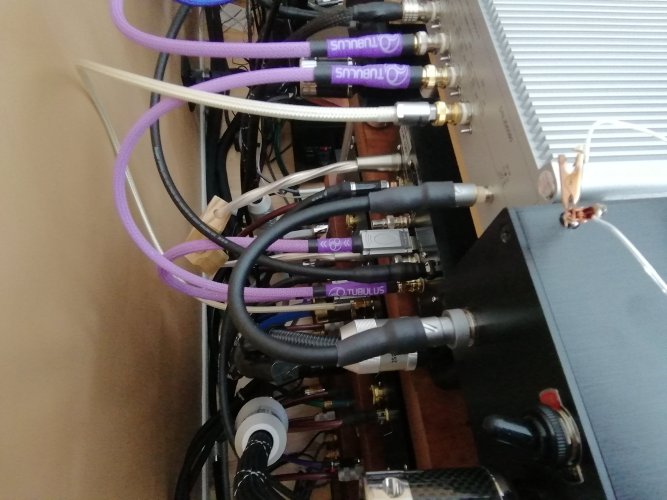Not sure this is what you had in mind.... but I'll offer my R8HE mod experience which may temper your actions [or not!]Has anyone done a DIY with parts from audio-gd?
I see DA boards can be purchased.
Im dreaming of a really small dac with dc input.
I hope my data points are useful to you in some way.
When I saw the DA-7 MKI DAC boards for sale about two months ago[?] I inquired about the possibility of adding them in parallel in my 2019 R8HE.
I wanted to buy three pair to go with the existing 2019 DA-7 DAC boards to make a 4 DAC per-channel R8.
For reference, I read everything I could on DIY parallel DAC projects - one concluding that after the second DAC there were diminishing returns, a second perspective concluding that resolution continues to improve with more DACs. The kicker for me was an MSB owner saying he sold his Select DAC for a Reference, then went to the Premier electing to put his money on the best source - after getting a Taiko Extreme, he no longer missed the more expensive MSB DACs... FWIW.
Two boards will fit stacked in the existing 2019 R8HE chassis. If I reduced the height of the standoffs at the bottom of the chassis in the R8 I would be able to fit four of them stacked.
Immediately after my request/inquiry to AGD, the URL sell sheet for the DA-7 MKI was taken down.
But as with adding R8 master clock input, I persisted and eventually received an answer....
but with signature from another AGD employee, not Kingwa, and it was not a positive experience thereafter due to poor communication and lack of reliable follow-through.
So AGD would sell me the boards under the hypothetical that they had never tried it but thought in theory it should work and I assumed full responsibility. OK fine...
My December 2019 R8HE I believe was at the end of the 92 piece resistor ladder DA-7 board production where the 140 piece resistor ladder MKI DAC board came to be.
So I decided not to go with four per-channel all at once and ordered two pair for two MKI DAC boards in parallel per-channel.
Some of the minutia I had to wade through on my own was
- at what point do both the digital and analog PSs run out of current when adding additional DA-7 MKI boards? I suspect the answer is two but I don't know.
- how many DA-7 boards would the Data, BCK and WCK feeds off the FPGA work with without buffering?
- what would the effect of the ACSS circuit have being fed double the current with each doubling of boards?
Fast forward to getting them to work -
After requesting the modules to be used as explained above I was shipped the CPLD FW version for direct IIS input and not what was needed - to accommodate the signals coming from the FPGA.
So then I had to buy a $37 Blaster specific for the CPLD flash.
After learning that I needed the blaster, I used the ten days waiting for the blaster shipped from China to try to connect the MKI directly to IIS [as supposedly shipped] but I was unsuccessful.
It took about 5 hours to eventually figure out how to get the .jed file from Windows to the Oracle Virtual Box used to run the CPLD Blaster from my laptop.
If you do this for a standalone DIY DAC fed directly by IIS, you will [hopefully] not need to do this...
It worked but the channels on the MKI played out of phase. I mimicked the solder pad options found on my original DA-7 and the MKI boards then worked as they should.
Turns out that the solder pad options on the newly shipped MKI boards were configured for the R7 which per AGD, are configured out of phase to work on that platform.
After about an hour of warm up, it was clear that the level of inner detail and calm ease upgrading to a single DA-7MKI was easily distinguishable. I did not hear any improvement for DSD however.
Adding the second MKI in parallel immediately added further detail and ease but having to wait another 100 hours for the second MKI board to settle in makes reliable long term comparison between one and two DAC boards unreliable.
After adding the second DAC board, one of the channels was introducing static over the music when playing DSD. All PCM up to 384K played fine.
I suspect that with the higher DSD speeds, the data from IIS inputs from the FPGA may be at fault from impedance loading from two sets of boards.
I'm waiting on some SMD breakout boards to add signal buffers to isolate/regenerate each of the IIS data lines from the FPGA to see if that fixes it.
I feel confident that it will.
In the mean time, for a functional solution, I can transcode DSD to PCM 352.8 in Roon although I don't listen to DSD other than to compare to their hi-res PCM versions.
This is a work in progress and I have additional work ahead. Based on the poor communication flow I've decided not to purchase the additional DAC boards.
I am quite happy with the jump in improvement both from the legacy DA-7 and to two paralleled MKI versions.
Rich
Supplemental: After references to "fast power supplies" from Antipodes Audio and having experienced Server/Player LPS to Hybrid LPS/SMPS factory upgrade improvements along with utilizing the Ferrum Hypsos to replace the LPS in my SingXer SU-2 DDI [also producing very notable SQ improvements], I used the Hypsos to supply 5V to the digital section of the R8 and found a notible resolution improvement in SQ. The Antipodes and the Hypsos are using DC-DC converters after the bridge rectifer. Again, FWIW...
Last edited:

























